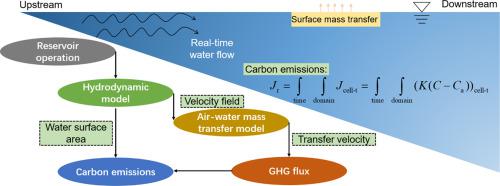Water Research ( IF 11.4 ) Pub Date : 2023-05-23 , DOI: 10.1016/j.watres.2023.120118 Juping Huang 1 , Zhe Li 1

|
Air-water diffusive carbon fluxes (e.g., CO2 and CH4) in reservoirs, particularly those dammed in river valleys, are the major pathway of reservoir carbon emissions. Hydrodynamic conditions caused by real-time reservoir operation could potentially affect air-water transfer of these greenhouse gases (GHGs), yet still under explored. Here, we proposed an estimation method of gross carbon emissions based on a computational fluid dynamic (CFD) modelling approach. The model assumed that air-water mass transfer was primarily regulated by surface turbulence, and disregarded contributions from biogeochemical processes as well as seasonality of meteorological parameters (i.e., wind speed and direction; air temperature). Through the hydrodynamic modeling, reservoir water level, flow velocity, surface turbulence, and air-water transfer velocity of carbon fluxes were elaborated. Gross carbon emissions were integrated by the carbon fluxes in each discrete cell and time under real-time reservoir operation. The Xiangjiaba Reservoir (XJB), located in the upper Yangtze Basin, was selected as the case of the study. Based on daily hydrological data in 2018, such as reservoir inflow, outflow and water level, the gross CO2 and CH4 emissions in the reservoir were approximately 6.7 Gg and 5.6 Mg. Variations of daily water level and discharge induced by reservoir operation could evidently affect carbon emissions. In particular, when reservoir initiated its impoundment, the discharge could be the probably critical factor that affected mass transfer velocity and carbon emissions in the reservoir. Our model could provide a new vision for evaluating the effect of real-time reservoir operation on carbon emissions.
中文翻译:

实时水库运行影响的碳排放:与空气-水传质相结合的水动力建模方法
空气-水扩散碳通量(例如CO 2和CH 4)水库,特别是河谷筑坝的水库,是水库碳排放的主要途径。实时水库运行引起的水动力条件可能会影响这些温室气体(GHG)的空气-水传输,但仍在探索中。在这里,我们提出了一种基于计算流体动力学(CFD)建模方法的总碳排放估算方法。该模型假设空气-水质量传递主要受表面湍流调节,并忽略了生物地球化学过程以及气象参数(即风速和风向;气温)的季节性的贡献。通过水动力模型,详细阐述了水库水位、流速、表面湍流以及碳通量的空气-水传递速度。总碳排放量通过水库实时运行下每个离散单元中的碳通量和时间进行积分。选择位于长江上游的向家坝水库(XJB)作为研究案例。根据2018年水库进流量、出流量、水位等逐日水文数据,总CO2水库中的2和 CH 4排放量分别约为 6.7 Gg 和 5.6 Mg。水库运行引起的日水位和流量的变化会明显影响碳排放。特别是,当水库开始蓄水时,流量可能是影响水库传质速度和碳排放的关键因素。我们的模型可以为评估实时水库运行对碳排放的影响提供新的视角。











































 京公网安备 11010802027423号
京公网安备 11010802027423号